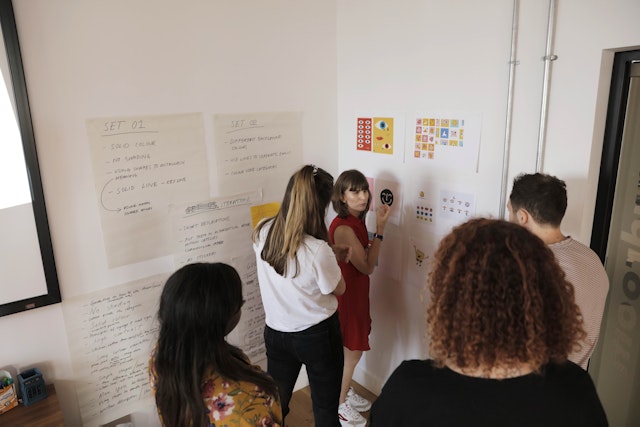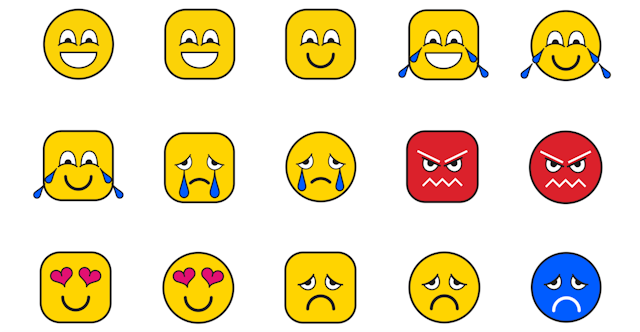What happened when the RNIB and We Are Social redesigned emojis for the blind
As ardent emoticon lovers across the globe celebrate 'World Emoji Day,' the Royal National Institute of Blind People (RNIB) worked with We Are Social to figure out how to redesign emojis for partially-sighted people.
It wouldn’t cross many minds what a privilege it is to have 2,800 emojis, readily available at their fingertips. But for the 2 million people living with sight loss in the UK, for various reasons, typing with emoji's is a difficult task and can lead those with limited vision to feel left out from their peers.
"We wrote out a brief and sent it across the whole department saying it's World Emoji Day, we should do something," explained Alastair Campbell, executive creative director at We Are Social.
"One of the ideas that we really liked was 'can we create a set of emojis that work for partially sighted people?' The project is about inclusion. It's about the emotional effect of these things on people who want to feel that their disability doesn't define them."

We Are Social partnered with RNIB, which has been on a mission to make websites more accessible for partially-sighted people. The charity has its own usability site where a panel of people with varying degrees of vision act as test participants for brand's trying to make their websites more inclusive.
"We wanted to create an accessible set of emojis that fit the needs of people who have sight loss across a whole spectrum," explained Sarah Bailey, marketing manager at RNIB.
There was a lot to consider in terms of the way people use assisted technology.
"You have people who are blind to screen readers, which means they're not focusing on the visuals but on the labels of emojis," Bailey continued.
For partially sighted people, limited vision leads them to look for "very distinct features like outlines, colours and shapes."
To understand the design elements of emojis and how they appear to those who are visually impaired, RNIB and We Are Social brought together a creative team to kick off the project with a one day workshop.

Firstly, they broke down the key issues that people with short-sightedness struggle with. These included: differentiating emojis due to the level of detail such as shading, colour and contrast; identifying emojis, especially when three or more are used in a row in a social post or message; and selecting an emoji's which are are uncategorised and grouped close together.
They then tried to understand the problem in context by evaluating current methods that partially sighted people use to navigate emojis.
"From this process, we were able to determine that the two main methods currently used are voice-over technology, which is a slow process and magnifying/zoom functions, which can be frustrating to use," explained Sam Cox, senior creative technologist at We Are Social.

Once they established that, the team broke down which visual elements of the current emoji sets made them hard to read, using the top 10 most used emojis from last year.
From there, they established where they could improve on the design, by creating two sets of visual design routes.
For inspiration, they looked outside the emoji world - playing around with different graphics, layouts, colours and symbols. This practice helped them piece together some basic rules to support the development of the two routes.

Throughout the second half of the day, Cox said the team "illustrated both design routes and, at times, even merged together elements from both. The day took the form of rapid prototyping, with Bailey giving constant feedback as to what worked well and not so well."
By the end of the workshop, the team had a set of emojis that they felt were more accessible for people who are partially sighted.

The emojis are now getting tested at RNIB's testing faculty in Peterborough to gain initial feedback while the We Are Social team has begun compiling an initial set of guidelines for emoji use for visually impaired people, which can be quickly, and easily implemented to make a difference.
Alexandra Hoste, head of creative at RNIB said the charity already has a set of guidelines pinned at the top of its Twitter regarding making social media accessible.
"It's a really quick way to get it to people," she said. "With this set of guidelines for emoji use, we will also put it as a pdf on our website so people can download. But it would also be great for platforms that use emojis to share, as it started with them."
Following on from that, Campbell said "it would be great to get it to the position that, where you have an emoji of a girl and you can choose from the various skin tones, at the end of that, you have an 'accessible' version."
It's unclear how long that process would take, given the amount and variation in the emoji keyboard.
"We though that rather than make it through emojis, we could make it though sticker packs," said Campbell. "Where we redesign a more limited top 50 emojis."
We Are Social and RNIB are yet to reach the major platforms like Apple and Google who have their own variations, and Unicode - the official body that looks after them.
"It would be nice to get to a point of having redone all of them, and petition to Unicode to make it an option," Campbell said.

